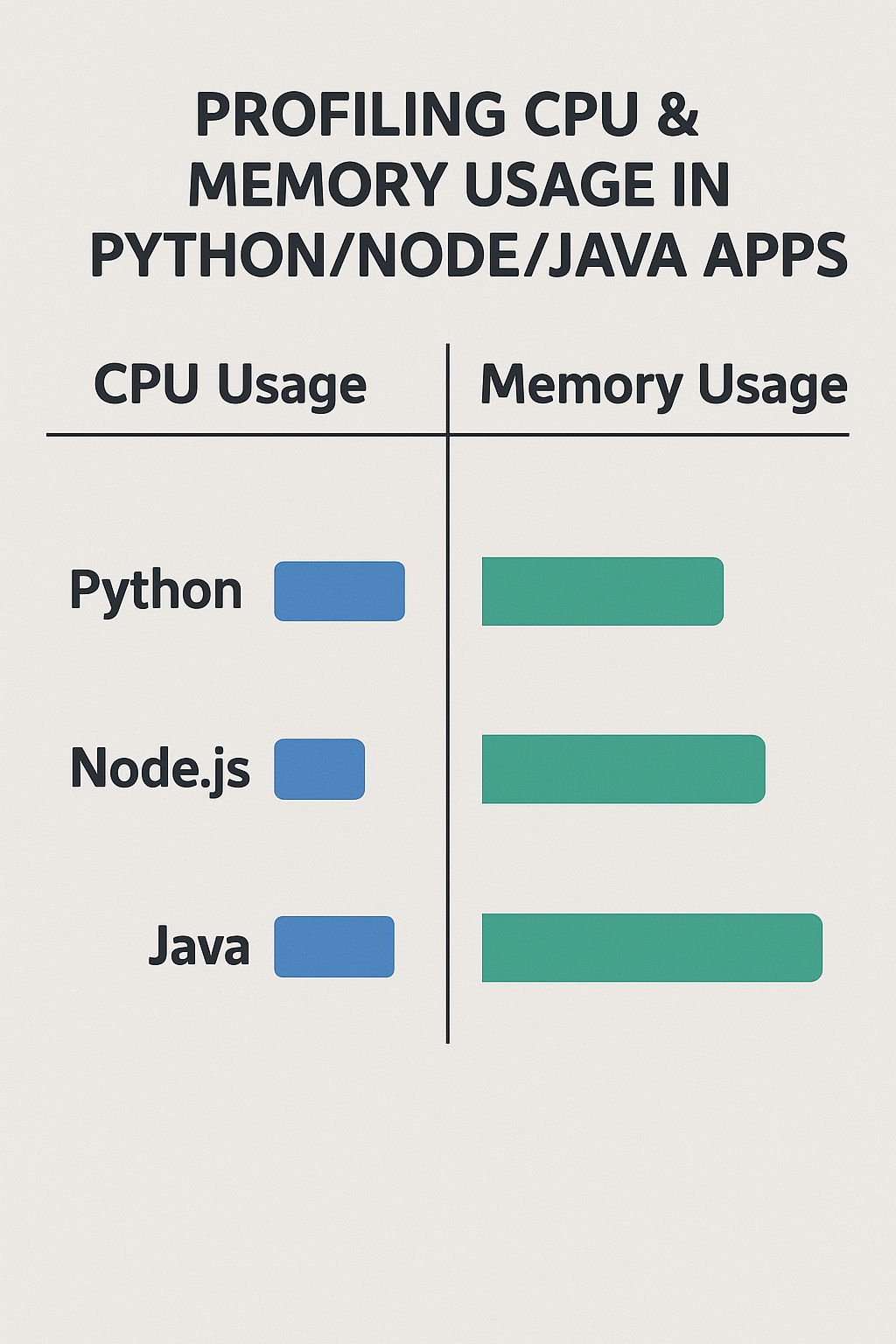
Introduction
As applications grow, so does the need to understand where performance issues come from. High CPU usage, memory leaks, and slow functions can turn a smooth-running system into a bottleneck. Therefore, profiling your application becomes essential for diagnosing problems quickly. In this post, you’ll learn how to profile CPU and memory usage in Python, Node.js, and Java, along with the best tools and workflows for each language.
Why Profiling Matters
Profiling shows you exactly where your app spends time and memory. As a result, you can optimize the right areas instead of guessing. Additionally, profiling helps you:
- Detect memory leaks
- Identify expensive functions
- Analyze garbage collection patterns
- Improve latency and throughput
- Ensure scalability under load
Better performance leads to happier users — and more predictable production behavior.
Profiling in Python
Python offers several built-in and third-party tools for performance analysis.
Use cProfile for CPU Profiling
cProfile is Python’s built-in profiler and is perfect for measuring where time is spent.
Run a script with CPU profiling:
python -m cProfile -o output.prof app.py
Visualize Results with SnakeViz
pip install snakeviz
snakeviz output.prof
SnakeViz turns your profile data into an interactive chart, making it easier to understand hotspots.
Detect Memory Leaks with tracemalloc
Python’s tracemalloc helps track memory allocation over time.
Example:
import tracemalloc
tracemalloc.start()
# run code
print(tracemalloc.get_traced_memory())
Additional Tools
- memory_profiler – line-by-line memory usage
- PySpy – low-overhead sampling profiler
- Scalene – CPU + memory + GPU profiler with detailed breakdowns
Because these tools work well together, Python developers can quickly understand where performance drops.
Profiling in Node.js
Node has a strong set of built-in profiling tools, thanks to V8 and Chrome DevTools.
Use the Built-In Profiler
Start Node with:
node --prof app.js
This generates a .log file with CPU execution data.
Analyze Using DevTools
Open Chrome DevTools → Performance → Load the profile file.
This gives flame graphs and timing insights similar to browser performance tools.
Memory Profiling with Heap Snapshots
You can take heap snapshots directly from DevTools or by starting Node with:
node --inspect app.js
Then open chrome://inspect to access heap snapshots and memory tracking.
Great Node Profiling Tools
- Clinic.js (Doctor, Flame, Bubbleprof) – extremely helpful visual profilers
- 0x – fast, user-friendly flamegraph tool
- Heapdump – create
.heapsnapshotfiles programmatically
Profiling Node apps becomes easier when you combine DevTools with Clinic.js.
Profiling in Java
Java provides some of the most advanced profiling capabilities due to the JVM ecosystem.
Use Java Flight Recorder (JFR)
JFR is built into the JVM and provides deep insights into CPU, memory, and GC.
Start a JVM with JFR enabled:
java -XX:StartFlightRecording=filename=profile.jfr -jar app.jar
Visualize with Java Mission Control (JMC)
JMC provides detailed flame graphs, GC timelines, thread analysis, and memory charts. It’s extremely powerful for production-grade analysis.
Use VisualVM
VisualVM is a go-to profiler for many Java developers.
You can:
- Monitor CPU usage
- Inspect heap dumps
- Track memory leaks
- Analyze thread deadlocks
Other Useful Java Profilers
- YourKit – paid, but extremely advanced
- JProfiler – great UI and clear reporting
- Async-profiler – lightweight sampling profiler for native-level performance
Because Java apps often run in large systems, profiling tools like JFR are invaluable for tracking long-running issues.
Best Practices for Effective Profiling
- Profile locally and in staging, not only in production
- Always generate baseline metrics before optimizing
- Use sampling profilers when possible to avoid overhead
- Reproduce performance issues with realistic data
- Combine CPU + memory + GC profiling for a complete picture
- Document findings and changes to avoid regressions
Following these practices ensures that your optimizations are based on real data rather than guesses.
Final Thoughts
Profiling CPU and memory usage is essential for building fast, scalable applications. Whether you’re working with Python, Node.js, or Java, the right tools can give you deep insight into your application’s performance. Once you identify bottlenecks, optimization becomes a precise and focused task. To continue improving app performance, check out Using Docker for Local Development: Tips and Pitfalls. For official resources, explore the Node.js profiling guide.